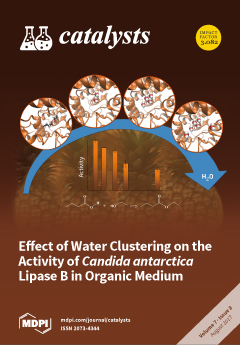NaOH-modified TiOF
2 was successfully prepared using a modified low-temperature hydrothermal method. Scanning electron microscopy shows that NaOH-modified TiOF
2 displayed a complex network shape with network units of about 100 nm. The structures of NaOH-modified TiOF
2 have not been reported elsewhere.
[...] Read more.
NaOH-modified TiOF
2 was successfully prepared using a modified low-temperature hydrothermal method. Scanning electron microscopy shows that NaOH-modified TiOF
2 displayed a complex network shape with network units of about 100 nm. The structures of NaOH-modified TiOF
2 have not been reported elsewhere. The network shape permits the NaOH-modified TiOF
2 a S
BET of 36 m
2∙g
−1 and a pore diameter around 49 nm. X-ray diffraction characterization shows that TiOF
2 and NaOH-modified TiOF
2 are crystallized with a pure changed cubic phase which accords with the SEM results. Fourier transform infrared spectroscopy characterization shows that NaOH-modified TiOF
2 has more O–H groups to supply more lone electron pairs to transfer from O of O–H to Ti and O of TiOF
2. UV–vis diffuse reflectance spectroscopy (DRS) shows that the NaOH-modified TiOF
2 sample has an adsorption plateau rising from 400 to 600 nm in comparison with TiOF
2, and its band gap is 2.62 eV, lower than that of TiOF
2. Due to the lower band gap, more O–H groups adsorption, network morphologies with larger surface area, and sensitization progress, the NaOH-modified TiOF
2 exhibited much higher photocatalytic activity for Rhodamine B (RhB) degradation. In addition, considering the sensitization progress, O–H groups on TiOF
2 not only accelerated the degradation rate of RhB, but also changed its degradation path. As a result, the NaOH-modified TiOF
2 exhibited much higher photocatalytic activity for RhB degradation than the TiOF
2 in references under visible light. This finding provides a new idea to enhance the photocatalytic performance by NaOH modification of the surface of TiOF
2.
Full article





